The following is a guest article written by friend of the site, T. Kyle King from the Wrapped in Podcast. This is easily one of the best theories I’ve read since the show ended. Hope you enjoy it as much as I do! – Andrew
Twin Peaks: The Return is behind us, yet enduring questions remain – as, indeed, they always will. As David Lynch himself famously said of his work, “It’s so beautiful just to leave it abstract. Once it becomes specific, it’s no longer true to a lot of people, where, if it’s abstract, there could be some truth to it for everybody.” This certainly was the case with Parts 17 and 18 of Twin Peaks: The Return, so what follows is intended not as the definitive specific solution, but rather as one fan’s truth of the series’ ending.
For me, the sequence in the Twin Peaks Sheriff’s Station at the midpoint of Part 17 is the key to everything. Up until that point, Part 17 had been 30 straight minutes of relatively linear narrative. Everything initially seemed like it was adding up, but, the instant “the Cooper super” appeared over the screen, a divergence occurred; Mr. C. was gone, but still there were two Coopers, literally visible on the same screen, one atop the other. Notably, the first lines uttered after this double-image appeared were Bobby Briggs’s baffled question and Bradley Mitchum’s forthright answer. They spoke not just for all of us in the audience, but also for Lynch himself: We were not meant to comprehend what happened from that point forward – yet Major Briggs clearly did, and Agent Cooper ostensibly does.
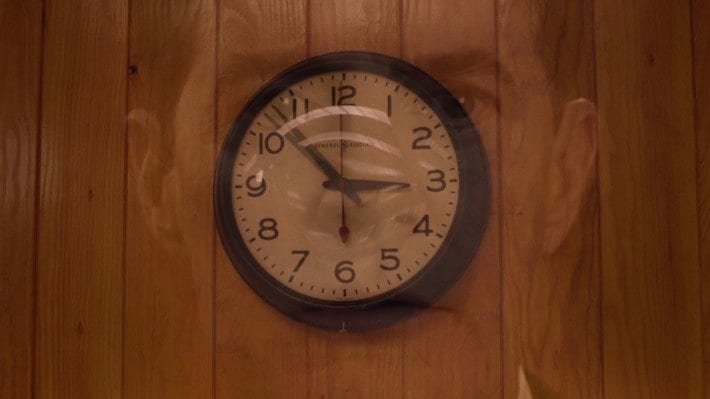
Coop says Gordon is arriving right on time, yet Gordon previously had been unsure whether the plan was working as intended and was concerned that Cooper’s call was overdue. To the group, Coop says, “And that’s what’s brought us to where we are today” – effectively ending the narrative that was the first sixteen and a half hours of Twin Peaks: The Return. He then turns to face the camera, and two Coopers’ faces are looking out at the viewer when one of them says: “Now there are some things that will change. The past dictates the future.” In between these two sentences, Deputy Chief Hawk – who, like Phillip Jeffries, is aware of things he isn’t willing to discuss – nods knowingly.
The other Cooper, speaking directly to the audience and evidently to no one else, straightforwardly says: “We live inside a dream.” The first Coop then tells his assembled friends, “I hope I see all of you again. Every one of you.” At that point, ominous music swells, darkness inexplicably descends, and the seemingly physical Cooper calls out to Cole, who calls out to Coop in return – then they fade, the ethereal floating Cooper head solidifies in darkness, and the remaining 90 minutes bear only minimal resemblance or connection to what has come before.
What happened in this critical transitional moment? In the midst of so many cross-currents of ostensible subtext, I’m sticking with the text: Cooper says, “We live inside a dream” – and I take him at his word. Essentially everything that happens after the Cooper super appears happens in a dream, Dale Cooper is the dreamer who dreams and then lives inside the dream, and Naido put him there, because Naido is Judy.
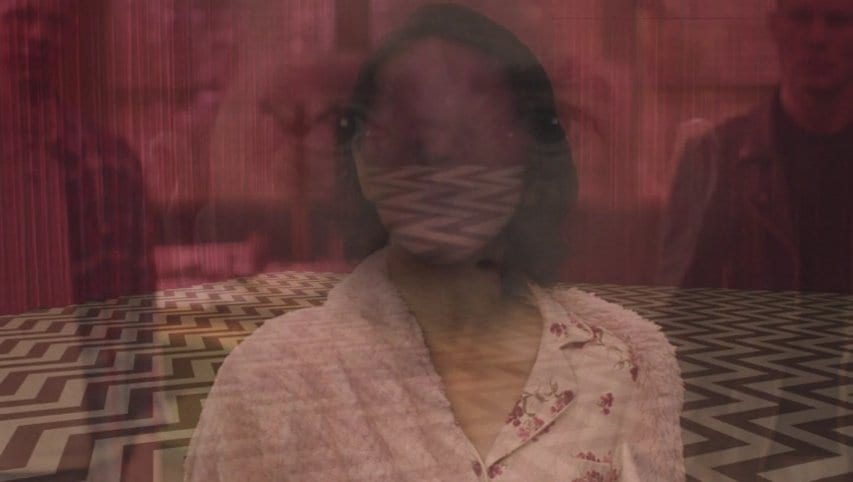
There are numerous clues throughout Part 17 pointing us toward this conclusion. Twin Peaks: The Return had a remarkable degree of symmetry to it, so it follows logically that, after the sleeper awakened halfway through Part 16, he went back to sleep halfway through Part 17. Shortly before that happened, in fact, bad guy Chad sprung into action after the repetitious drunk briefly awakened and went back to sleep. The drunk otherwise serves no narrative purpose, and Chad’s actions make no independent sense. As a cue to what’s happening with Cooper upstairs, however, the sleeper waking up before nodding off again shortly thereafter is perfectly congruent.
The Cooper super, indicating Dale’s re-entry into dreamland, appears as soon as Cooper looks at Naido. Within the confines of the story, this is explained away by the apparent revelation that Naido is Diane, but, like the rest of what follows, this makes linear sense only superficially and collapses upon closer scrutiny. (Regardless of how the misleading subtitles may have read, the word “in” was nowhere audible in the earlier statement supposedly uttered by the Diane tulpa that “I’m in the sheriff’s station.”)
Naido also reacted nervously to Doppelcooper’s arrival at the sheriff’s station, which seems strange. The Fireman, who sent Mr. C. there for the final confrontation, has been putting the pieces into place in preparation for this moment. Consequently, everyone who’s doing the White Lodge’s bidding is confident and at ease, even in the face of extreme danger. The Good Dale knows just what to do to send Bad Coop back to the Black Lodge; Freddie remains resolute about fulfilling his destiny even after BOB bloodies him; Andy doesn’t panic when Chad pulls a gun on him; only Naido is frantic. Why would Naido be in such a state unless she and the Fireman were at cross purposes?
Finally, the coordinates the Diane tulpa texted to Mr. C. after receiving his “:-) ALL” text evidently led Doppelcooper to the place from which the Fireman was able to deposit him at the Twin Peaks Sheriff’s Station. If this is the Diane tulpa’s moment of clarity – “I hope this works!” – and Naido is Diane, why would Diane text Bad Coop the coordinates that she knew would place the real Diane at risk?
In light of all that, it makes no sense for Naido to be Diane, so she must be someone else, and who she really is must explain why and how she fools Cooper into thinking she’s Diane. By far the most sensible explanation is that this important unidentified Asian female character is Jiao Dei, an ancient name that the Western tongue ultimately bastardized into “Judy” – just as, over time, a similar Eastern consonantal shift might well have changed Jiao Dei into Nai-doh. Accordingly, Naido is Judy, and what’s troubling her about Mr. C.’s arrival is the fear that Doppelcooper and BOB will dispense with Cooper and deny her the privilege of doing so (and of collecting his garmonbozia in the process).
It’s when our Dale first sees Naido that his giant disembodied slow-talking dream head appears, just as it was when our Dale last saw Naido that the giant disembodied slow-talking dream head of his Judy-pursuing compatriot, Major Briggs, appeared to say, “Blue rose” – thus delivering the ultimate coded warning between these colleagues that Naido was not what she seemed. (He certainly wouldn’t have used that artificiality-revealing phrase to mean that Naido was the real Diane!) It’s when our Dale makes physical contact with Naido in Part 17 that the time displacements begin, just as it was our Dale’s physical contact with Naido in the Mauve Zone that ended the similar time displacements in Part 3. We know the time displacements have begun here because the clock remains perpetually on the cusp of switching from 2:52 to 2:53, which is exactly the time change we saw occur on Naido’s wristwatch in the Mauve Zone.
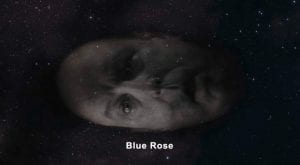
What Naido does here, therefore, is what Naido did the first time we saw her, in Part 3. There, she caused Cooper to change course and take a different panel back into the real world. MIKE, who clearly was working to maneuver Cooper back into his old self, made no bones about Dale’s situation: “Don’t die!” “You were tricked!” “Wake up!”
Who tricked Coop by putting him to sleep so he could be killed by the villains in Part 3? It was Naido – Judy – and that’s exactly what she did here, as well. It only looks different to us now because, from Part 3 through Part 15, we saw Dougie Coop’s dream state from the outside looking in, and, this time, we’ve joined Dale in the dream. This, however, allows us to see that Judy has learned from her previous mistakes. In Part 15, the incongruous intrusion of the name “Gordon Cole” was the first jolt in shocking Coop back to consciousness, so, this time, Judy lets Cooper keep his own identity, includes Gordon at the beginning of the dream, and has Dale himself tell his boss not to follow him into his increasingly divergent dreamscape in the boiler room of the Great Northern.
Judy likewise has learned that the key to compromising Cooper’s judgment is to cloud his reason with affection and guilt over a woman he failed to save. It happened with Caroline Earle, Audrey Horne, and Annie Blackburn in turn, so Judy inserts herself into the dream, disguised as Diane Evans, and she sends him on a futile and unending quest to rescue Laura Palmer. These are the two iconic abstract female avatars in Dale Cooper’s life – the one we never saw in the original series and the one he never met on this Earth – and the violent crimes committed against the two of them continue to haunt him. They’re the perfect albatrosses around Dale Cooper’s neck to serve as the anchors that will drag him permanently down into the dream. By masquerading as Diane, Judy is also able to remain a presence within the dream, where she can watch him while hiding in plain sight as a constant reminder of his need to continue into perpetuity his quixotic subconscious crusade. (Besides, it’s Twin Peaks, so, naturally, there have to be two of them.)
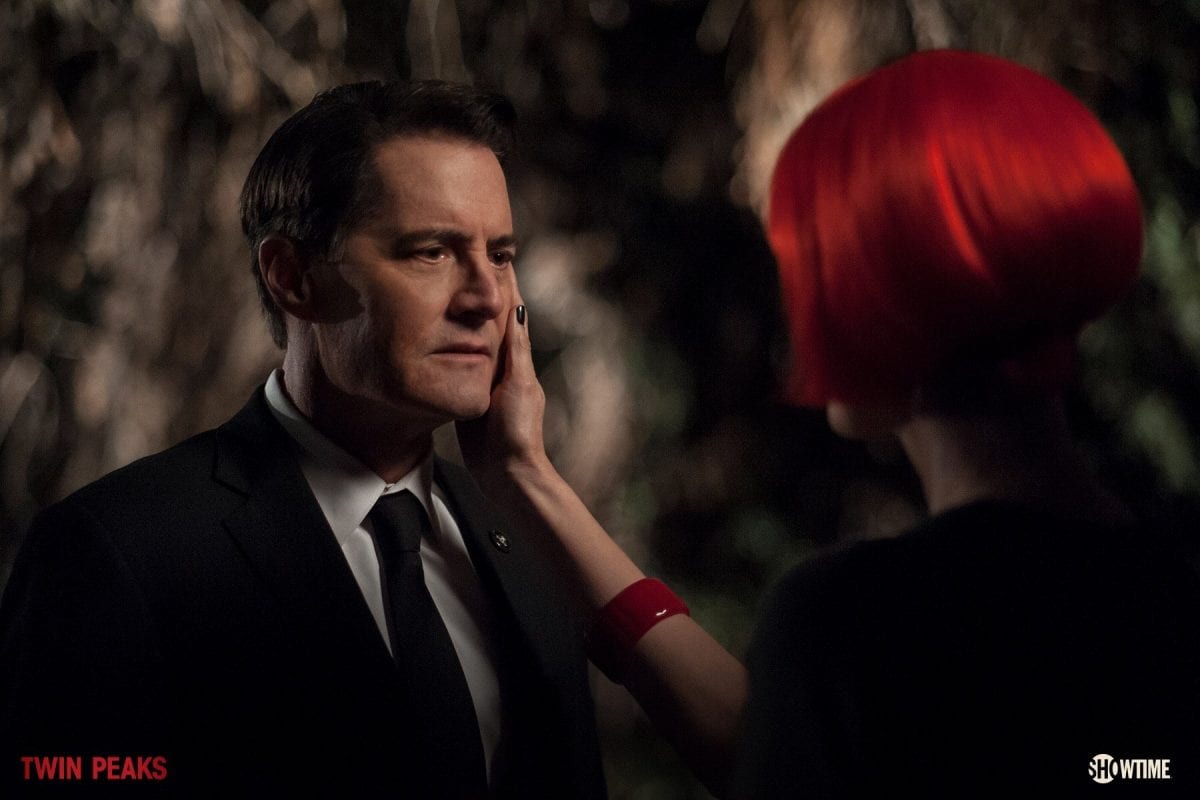
Moreover, a dream is the perfect trap for ensnaring Dale Cooper. He trusts his intuition, oftentimes to the detriment of reason, but he is oblivious to his own ignorance. Although Coop understands the mechanics of acetylcholine neurons firing high-voltage impulses into the forebrain, he’s clueless about the content, believing that “no one knows why we choose these particular pictures.” Judy has shrewdly used his trusting wonder against him by selecting the images that serve her sinister purposes. Judy is the water, the dream is the well, and Dale drinks full and descends into this world that increasingly is dark within.
In short, Naido tricked Coop into the waking dream of Dougietude to stop him from saving the day earlier, and she repeats exactly that same trick, only much more effectively, by putting him back to sleep to prevent him from completing Major Briggs’s plan now. What’s Naido’s motivation for doing so? It’s simple: Cooper’s, Gordon’s, and Briggs’s most significant mission was to find Judy and capture her. Naido has the ultimate incentive for wanting to prevent that, because Naido is herself Judy.
Accordingly, when the lights dim and Gordon and Cooper call out to one another in Frank Truman’s office, reality is intruding in a way the audience can perceive directly for the final time before Dale lapses fully into the Judy-induced dream. After that, every scene featuring the original Agent Cooper is contained wholly within Dale’s unconscious mind, which makes sense of everything that happens in the last 90 minutes of Twin Peaks: The Return.
It explains the dominance of “dream logic” in the progression of the plot. It explains the recurrence of scenes we know Dale Cooper has dreamt before, such as MIKE reciting the “Fire walk with me” poem, an older Dale waiting in the Red Room, and Laura whispering terrible revelations to Dale. It explains the otherwise inexplicable shifts in scene and nomenclature that Dale seems to take in stride, including his blasé acceptance of a murdered man in the middle of Carrie’s living room. It explains Cooper’s erratic and strangely detached behavior, not least of all his uncharacteristic and indifferent carelessness with firearms behind the counter at the Odessa diner.
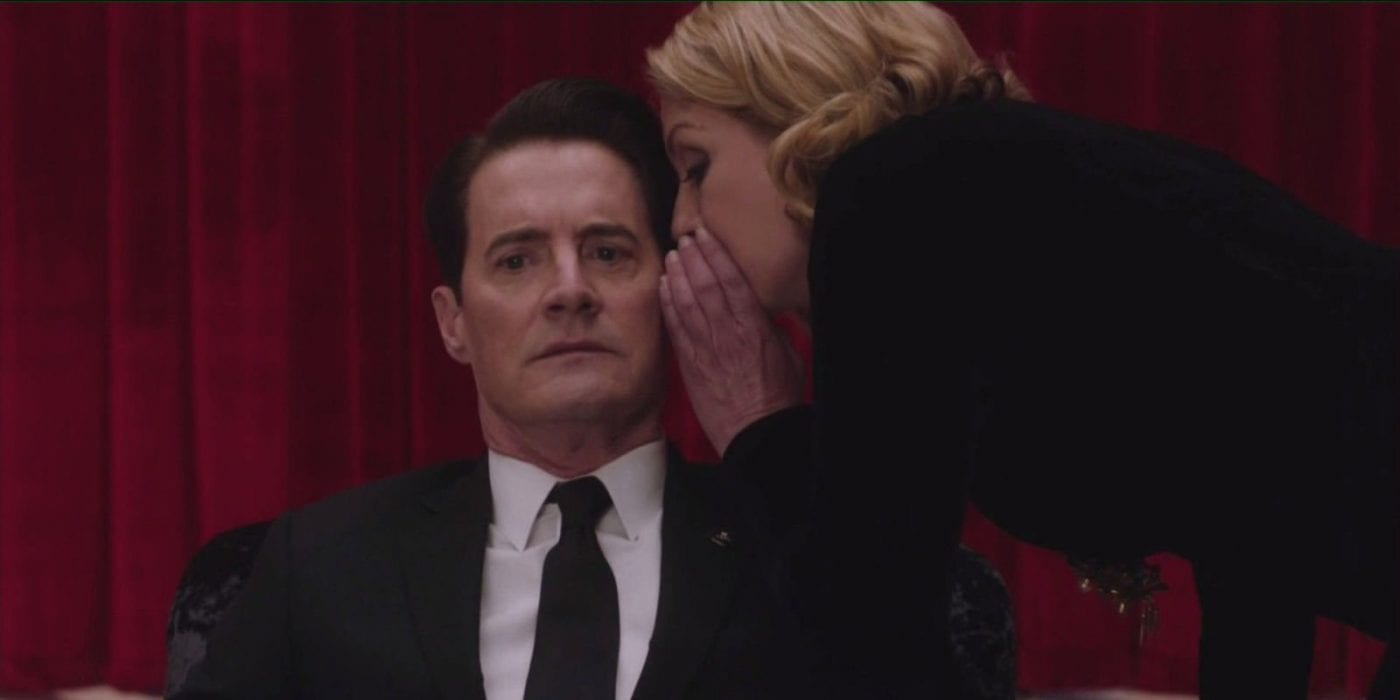
More importantly, it also explains the two dominant themes of Cooper’s extended and externally directed dream: Judy maintaining a constant presence so she can keep watch on Cooper and exercise control over the course of his dream, on the one hand, and Cooper’s reason attempting to break through the fog and bring him back to conscious awareness, on the other. These are the competing forces at work, vying for the upper hand, and this – not the expected faceoff between the Good Dale and Mr. C. that never came to pass – is, ultimately, the final battle between the forces of the White and Black Lodges. Can Cooper, his courage perfected by his time in the Red Room and his prior passage through his waking dream state as Dougie, overcome the original ancient evil of Judy by escaping from this trap before her wicked progeny can kill his catatonic form in the real world?
Judy is with him every step of the way, assuming multiple forms. However, because she is the “Mother” who gave birth to the evil that men do, she invariably assumes a female form, as she did both as “the young lady” from The Missing Pieces and as Naido. In the dream, she appears as Diane, as the waitress in the diner, as the driver of the car that tailgates Cooper on the highway, and as the current owner of the Palmer house. (Given the gender-fluidity of the Dutchman’s – where “Bosomy Woman” was played by a man and the Jumping Man wore Sarah Palmer’s face beneath his mask – it is conceivable that the Jumping Man on the stairs in Part 17 may be Judy lurking in the dream, as well.)
At every turn, Judy is watching him and directing him back toward Laura, or to the image of Laura, so that he can replay again and again his doomed efforts to save a young woman who chose to die more than 25 years ago. In addition to dredging up dreams Cooper has had before, Judy also exploits his memories: Cooper relives his experiences exiting the Red Room, this time with a telling twist. Judy – who is here disguised as the Evolved Arm that originally bore a tattoo that read “Mom” – steers him toward Laura, the little girl who lived down the lane. (Judy’s reliance on using Coop’s memories explains the absence of the “Double R To Go” sign when Dale and Laura – or, rather, Richard and Carrie – arrive in Twin Peaks, since this is the Double R as Dale remembers it, not as it now is.)
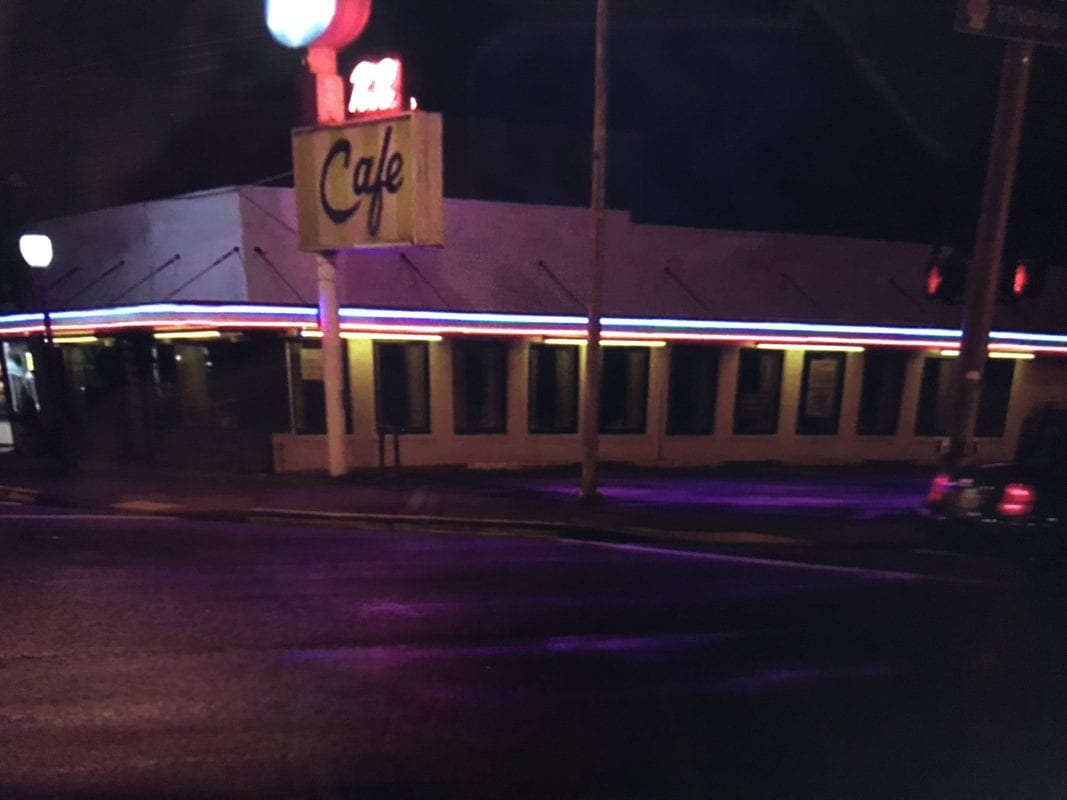
Although he is asleep, Dale’s brain knows better; as his somnolent self descended to dwell within the dream, his waking consciousness drowsily acknowledged that the past dictated the future just before he nodded off. Unfortunately, as MIKE’s repeated question makes plain, the dreamer is uncertain whether it is the future of Carrie Page or the past of February 23, 1989; nevertheless, Coop’s silenced reason endeavors constantly to break through into the dream, in order to force him back up to awareness. Cooper continuously sends these messages in bottles to himself.
We see it in MIKE’s befuddlement at the Dutchman’s. We hear it in Phillip Jeffries’s otherwise incoherent statement that “[t]his is where you’ll find Judy” – the only person he finds when he gets back to 1989 is Laura – and his pointed exhortation: “Cooper . . . remember!” (which sounds a lot like MIKE’s “Wake up!” and the Fireman’s “Remember 430”). It’s even visually represented in the motel room, in the form of the figure 8 and the marble that moves inside it:
Within the figure 8, the marble is flipped over to the other side, then it shifts back to where it began, signaling to Dale both what has happened to get him here and what has to happen to get him back. The small ball also looks like the seed into which a person is reduced by Lodge magic – representing Coop himself – which we know from Part 16 he is able to recognize. (This is a clue for the audience, too; in this show about doubling, we see in a figure 8 something he explained to us in Part 16.)
Finally, regarding the figure 8 itself, we know Cooper is a great admirer of the Dalai Lama, so, of course, when trying to guide his unconscious mind to a literal awakening into enlightenment, his reasoning brain would direct his dream along the eightfold path of Buddhism. Thus, the infinity symbol Judy attempts to project inside his mind – symbolizing the permanent recursion to which she has consigned him – is literally and metaphorically upended by Coop’s mind attempting to reassert itself. Since Judy will not permit the clock to strike 2:53, Cooper can never make 2+5+3 add up to the number of completion; because he cannot make it to 10, he must settle instead for 8: 10, from which two – Richard and Linda – have been subtracted. Viewed more positively, 8 is the Lucky 7 of 4+3+0, with one more added. Judy (as Naido/Diane) tried to fool him into believing he was that one (“and only”), but the Log Lady knew the truth: “Laura is the one.”
Likewise, when Cooper relives slightly altered versions of his memories, important differences emerge. When his unconscious mind takes him back through his exit from the Red Room in the premiere, Judy alters events so that the Evolved Arm – which looks like nothing so much as those acetylcholine neurons firing high-voltage impulses of which Coop is so well aware – speaks of the little girl who lived down the lane . . . but reason intrudes when that selfsame arm then poses the challenging question: “Is it?” (This reference to the little girl who lived down the lane – a phrase earlier introduced by Audrey – likewise ought to remind us that it was Audrey who said: “Dreams sometimes hearken a truth.”)
When Cooper dreams of awakening as Richard in the wrong motel room and driving away in the wrong car, his reason tries to warn him by attaching the name “Judy’s” to the diner. When Dale is waiting in Carrie’s living room, evidently unaffected by the all the oddities around him, a ringing phone intrudes yet is never answered; this is Coop’s awareness calling him in the most literal way possible within the confines of his delusion.
During the drive to Twin Peaks, Laura – “the one” who takes us to the number of completion; the golden child introduced into the world by the White Lodge as the countervailing good to Judy’s overwhelming evil – repeatedly is the voice of reason and remembrance. It is Laura, after all, who calls Cooper’s attention to Judy following in the car behind and makes comments carefully calculated to call to his mind the recollection of his meeting with her progenitor, the Fireman, at the start of Part 1. “I tried to keep a clean house.” “It is in our house now.” “It’s a long way.” “You are far away.”
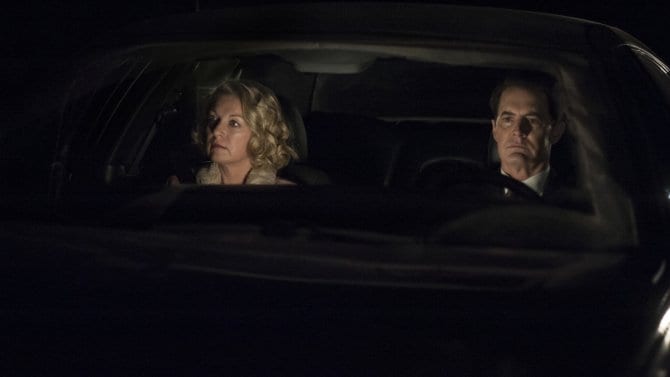
Who, then, wins in the end? In 1997, an article I wrote was published in Wrapped in Plastic, in which I called upon David Lynch to give Twin Peaks one of what I believed were his typical unconventional happy endings. I believe he gave us one here. Up until now, Cooper has gone along with the dream logic of everything that has happened, stoically accepting Laura’s disappearance in the woods, his and Diane’s time jumps, Laura’s new identity, and the general weirdness of his bizarre surroundings. At the very end of Part 18, though, his reason breaks through; his confusion indicates that he finally recognizes that this makes no sense, and that awareness begins his ascent back toward consciousness, exactly the way it really happens when a person awakens from a dream.
How do we know this is actually what’s happening? We know it because we previously saw Dale Cooper waking up after being tricked into a dangerous dream state by Judy in her form as Naido. How did that unfold? In Part 15, a statement made within the hallucination caught Cooper’s attention, and this first stirring of conscious awareness was followed by a flicker of electricity, the lights going out, and the blonde woman who was with him screaming.
This time, we’re looking at it from the inside, but exactly the same sequence seeps down into the dream from the real world outside. There is a flicker of the e-lec-tri-city MIKE mentioned at the Dutchman’s (in another instance of reason attempting to break through), the lights go out (this time, in the Palmer house), and a blonde woman (in this case, Carrie) screams, arresting Dale’s wandering attention and snapping him back to full awareness. This methodically repeated sequence is as sure a sign as it is possible for us to get from our perspective within the dream that Agent Cooper once again is waking up and that Judy has been defeated.
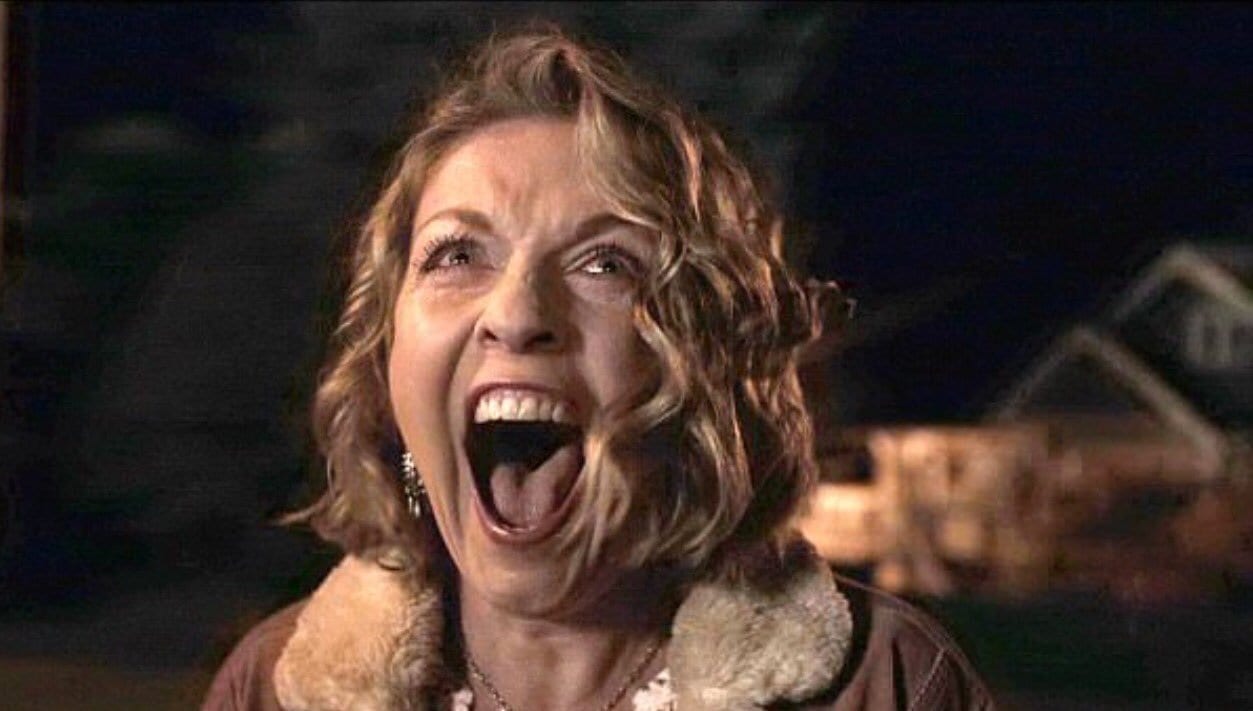
The question “What year is this?” – mirroring MIKE’s inquiry “Is it future or is it past?” – isn’t the new “How’s Annie?” Instead, it’s the new “Get Gordon Cole!” Since we are living inside the dream that is ending, the screen fades to black before we are able to see it, but the unseen next scene of Twin Peaks: The Return is Dale Cooper’s triumphant reawakening. What follows outside our observation is the perfect inversion of the frustration of the closing moments of the season two finale: Cooper awakened there, in Room 315 of the Great Northern, with Sheriff Harry Truman beside him, to the realization that evil had been victorious; he awakens here, having been given the key to Room 315 of the Great Northern by Sheriff Frank Truman, with the knowledge that good has won out in the end.
When the dream concludes, Coop wakes up, the clock finally strikes 2:53, and Dale – the only one who understands fully the long game the Fireman and Major Briggs were playing – reveals to the assembled lawmen in Harry’s office that Naido is really Judy instead of Diane. Given the juxtaposition of the dimming lights both in the sheriff’s station at the beginning of the dream and in the Palmer house at its ending, perhaps what Judy portrays with horror within the illusion – Cooper and Cole calling out one another’s names in fear – plays out in reality upon Dale’s awakening as two old friends greeting one another in victory and in love: “Gordon!” “Cooper!”
The mother of all evil is led back downstairs to her cell – this time as a prisoner instead of in protective custody – to await the justice she must face at the hands of the Fireman, whose insights from Part 1 Coop truly came to comprehend in his darkest hour. We, too, now know that, in that monochromatic opening scene, the Fireman told the very special agent all he would need to know to free himself from Judy’s trap.
“Agent Cooper. Listen to the sounds.” The noise of the scratching phonograph first heard then would be repeated in Dale’s dream when Laura was whisked away at the end of Part 17. “It is in our house now.” The purple sea and the Phillip Jeffries bell visible both in the Mauve Zone in Part 3 and in the White Lodge in Part 8 make it clear that Judy (disguised as Naido) is in a space adjacent to the Fireman’s and Senorita Dido’s home. (Dale responds with the tentative “It is” of which his repressed reason later tries to remind him with the provocative question “Is it?”)
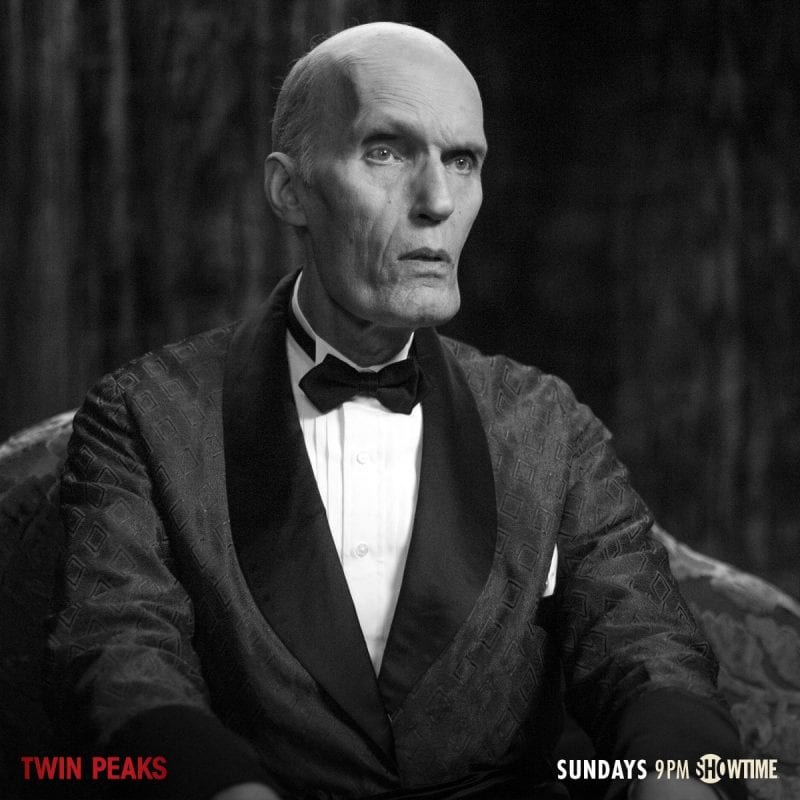
“It all cannot be said aloud now. Remember 430. Richard and Linda. Two birds with one stone.” The Fireman knows what is coming, and he is preparing Cooper to recognize it, so that, when the numbers “430” and the names “Richard and Linda” later appear in Coop’s Judy-induced dream, they begin the stirrings that gradually lead him back to full awareness. Dale says he understands, but he doesn’t yet. “You are far away” . . . from full comprehension, and from coming full circle the way the figure 8 visually depicted he would. Ultimately, though, the Fireman has said all that needs saying; as was true of the cryptic insights the Fireman provided in solving Laura Palmer’s murder 25 years earlier, Agent Cooper has all the clues he needs – as, in retrospect, do we.
Agent Cooper’s experience at the end of season three is the opposite of Audrey Horne’s; she awakens from a moment of idyllic fantasy into a harsh reality, while Dale departs from unconscious tragedy to conscious triumph. In season three of Twin Peaks, as in season one, Dale Cooper’s dream was a code, waiting to be broken – and, as before, breaking the code led him to solve the riddle of the season’s central mystery.